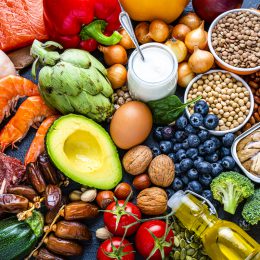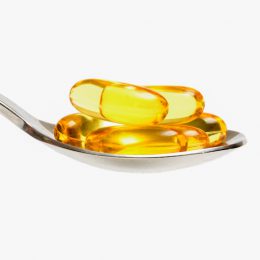Sodio: La guía de SilverSneakers para adultos mayores
El sodio es esencial para que el organismo funcione bien. ¿Pero cuánto es demasiado? Here's the salty truth about this important mineral.

There are two sides to every story, and the story of salt is no exception. It's a favorite food flavoring that you literally can't live without. It's also a major public-health enemy.
Salt contains sodium, an essential nutrient that helps your body function properly. But consuming too much sodium can wreak havoc on your health.
It's easy to get complacent about your sodium intake. After all, from added sugars to saturated fats, there are a lot of other components to worry about in your diet. But it is important to understand the role this electrolyte plays in your wellbeing as you age.
Use this guide to better understand sodium, where it comes from, and whether you should be cutting back your intake.
Healthy eating and fitness go together! With SilverSneakers, you can choose from dozens of different Community classes, visit a participating fitness location, or take online classes through SilverSneakers LIVE. Check your eligibility here.
What is sodium?
Sodium is a mineral that carries an electrical charge, known as an electrolyte. Ions of sodium, potassium, and chloride trigger muscle contractions and nerve impulses as they move across our cell membranes.
Although sodium and salt are often used interchangeably, they're not the same thing. Table salt is made up of 40 percent sodium and 60 percent chloride. For reference, 1 teaspoon of salt contains 2,300 milligrams (mg) of sodium.
What is the role of sodium in the body?
Sodium isn't inherently unhealthy. In fact, consuming a certain amount of sodium each day is essential for your health. Sodium is involved in many important bodily processes, including:
- Blood volume and blood pressure regulation
- Fluid (water) balance maintenance
- Muscle and nerve function
Sodium regulation occurs in your kidneys. If your sodium levels get low, your body sends a signal to your kidneys to absorb more of it. If your sodium levels become too high, your body lets your kidneys know it's time to get rid of the excess. Your body filters out excess sodium through your sweat, stool, and urine.
But regularly consuming high amounts of sodium can eventually override this safety valve, making it harder for your body to eliminate the excess. And over time, too much sodium in your bloodstream can lead to serious health issues.
What is the right amount of sodium for me?
Although there's some debate over how much sodium you should consume, major health organizations including the National Academies of Sciences, Engineering, and Medicine and the American Heart Association recommend that older adults limit their sodium intake to 1,500 mg per day. That a little less than 3/4 teaspoon of salt.
There is little evidence that going below the 1,500 mg mark is more beneficial. And you certainly don't want to try to eliminate all of the sodium from your diet. The body requires about 500 mg of sodium each day to function properly.
“A very salt-restricted diet may put an older individual at risk for poor overall nutritional intake, since some salt in the diet enhances the flavor of food and the sense of taste can decline as we age,” says Kathryn Piper, a registered dietitian nutritionist.
If you regularly work up a sweat through exercise, you may have a little more leeway when it comes to your sodium intake. That's because sodium is the major electrolyte found in your sweat. The more you sweat, the more sodium you expel from your body.
Could I be getting too much sodium?
Yes. In fact, many of us are likely consuming too much sodium.
Americans really like their salt. According to a report in the American Journal of Clinical Nutrition, 99 percent of U.S. adults consumed more than 1,500 mg of sodium daily, while 91 percent take in more than 2,300 mg. According to the Centers for Disease Control and Prevention, the average American takes in 3,600 milligrams of sodium per day — more than double the recommended daily limit.
What are the sources of sodium in foods?
Sodium occurs naturally in relatively low amounts in foods like milk, fish, and vegetables. This mineral is also added to many products by manufacturers.
“Long ago, food manufacturers used salt primarily as a food preservative, but today they add it mainly to improve taste and texture,” says Virginia–based dietitian Jill Weisenberger, M.S., R.D.N., creator of The Prediabetes Meal Planning Crash Course.
About 15 percent of our sodium intake comes from the sodium naturally present in our food. More than 70 percent of the sodium we consume each day comes from packaged, prepared, and restaurant foods, according to the U.S. Food and Drug Administration (FDA). The rest of the sodium in a typical diet is added when we're cooking food or sitting down to eat a meal. So even if a saltshaker is not on your dining table, Weisenberger says it's quite possible you are still consuming too much sodium.
Food manufacturers add sodium to a wide array of products on grocery store shelves. You might expect to find this in certain items, like soup broths and tomato sauce. But what about added salt in breakfast cereal or loaves of bread? Sometimes, the worst culprits are products that don't even taste salty.
Here are the heaviest hitters:
- Boxed meals (macaroni and cheese, pasta meals, rice meals, etc.)
- Breads and bagels
- Broths
- Canned soup
- Canned vegetables
- Cheese
- Condiments and salad dressings
- Deli meat, such as cold cuts and bacon
- Frozen meals, such as pizza and burritos
- Mixed nuts
- Pasta sauce
- Savory snack foods, such as chips and pretzels
- Vegetable juice
- Veggie patties
Some foods, like bread, might make their way into multiple meals during your day of eating. All those servings could add up to quite a bit of sodium, even though each serving might not contain a high level of sodium.
It’s especially easy to blow past your recommended sodium intake if you go out to eat at a restaurant. In a 2017 Circulation study involving 450 adults, researchers found that restaurant foods accounted for 70.9 percent of total sodium intake.
“Many people are surprised just how high sodium levels can be in many restaurant dishes, including ’healthier’ options like salads,” Weisenberger says.
A 2019 investigation in Appetite followed 993 adults surveyed during 229 dinnertime visits to 44 restaurants. Researchers found that 90 percent of people underestimated the amount of sodium in their meals by an average of about 1,000 mg per dish.
Thankfully, the FDA has released new guidelines in 2021 requesting that chain restaurants and food manufacturers voluntarily reduce sodium levels in 163 categories of the most-consumed foods. The move is to help reduce the average sodium intake of Americans by 12 percent (from the current daily average of 3,400 mg to 3,000 mg).
What are the health risks of consuming too much sodium?
Although sodium is vital for several routine body functions, too much can have adverse health effects, particularly for people who are sensitive to sodium.
Studies suggest that high-sodium diets are potentially associated with certain health conditions, including:
- High blood pressure
- Heart disease and stroke
- Kidney disease
- Autoimmune disease
- Certain cancers, including stomach
- Disruption of proper immune cell functioning
- Cognitive impairment
- Bloating
A 2016 study in the Journal of the American College of Cardiology tracked participants’ sodium intake over a span of more than two decades. The higher the sodium intake, the greater the participants’ 20-year mortality risk was. Each 1,000 mg increase in daily sodium intake was associated with a 12 percent increase in mortality risk from conditions like heart disease.
High sodium intake was also linked to a higher mortality rate in a 2022 European Heart Journal study of more than 500,000 adults. Very regularly adding salt to food was associated with a 28 percent greater risk of premature death compared with those who rarely added salt.
Excess sodium in your bloodstream pulls water into your blood vessels, increasing the total amount (volume) of blood inside them. More blood flowing through your blood vessels may spike your blood pressure.
"This makes the heart pump harder because it has to circulate more blood in a given time," Weisenberger says. And your heart isn't the only organ affected by this. Excess sodium and high blood pressure puts a strain on your kidneys and brain, too. Over time, this can lead to cardiovascular and other health issues.
What does it mean to be sensitive to sodium?
Some experts argue that high-sodium diets are more harmful for certain people than others, particularly any older individuals who are said to be “salt-sensitive.”
In a 2021 study published in the American Heart Association journal Hypertension, researchers determined that generally healthy adults with high sodium sensitivity were 43 percent more likely to develop high blood pressure in response to a high-sodium diet than those with moderate sensitivity.
It's tricky to determine who has a salt sensitivity, though. A trip to your doctor won't show how your blood pressure responds to a slice of salty pizza.
“Unfortunately, there is not a reliable method or laboratory test to tell if you are salt sensitive,” Piper says.
But research suggests that the older we get, the more sensitive we become to sodium. That means older adults are more likely to see their blood pressure rise in response to higher sodium intakes.
“Kidney function tends to decline with age, making it more difficult to excrete excess salt,” Piper explains.
Is there a way to make eating sodium less harmful?
Yes. Potassium is key to balancing out the sodium in your system.
"An important way to get rid of excess sodium is to excrete it in the urine," Weisenberger explains. "When your diet is higher in potassium, your kidneys release more sodium into your urine."
A 2022 study in The New England Journal of Medicine monitored the sodium and potassium intakes of 10,709 adults. Researchers found that the risk of cardiovascular events like heart attack increased by 18 percent for every 1,000 mg daily increase in sodium excretion (a good indicator of sodium intake). On the other hand, the risk decreased by 18 percent with every 1,000 mg daily increase in potassium excretion.
The findings also suggest that a higher sodium-to-potassium ratio was linked with greater cardiovascular risk over a 9-year timespan.
So how do you make sure you're getting enough potassium? Focus on eating plenty of fruits and vegetables, Weisenberger says. These foods are especially good sources of potassium:
- Leafy greens, such as broccoli and spinach
- Avocados
- Bananas
- Beans and lentils
- Butternut squash
- Potatoes
How can I find out how much sodium I’m eating?
While we’ve established that sodium isn’t inherently bad for you, it’s still important to keep tabs on your intake.
Because high-sodium foods don't always taste salty, it's important to check the nutrition label when you go grocery shopping. The nutrition facts label on packaged foods will list the total amount of sodium in each product. This is shown per serving both as a value in milligrams and as a percent of your Daily Value (DV).
Good to know: Currently, the DV for sodium is less than 2,300 mg per day. This figure does not yet reflect the 1,500 mg suggested by several health agencies.
Suscríbase a nuestro boletín informativo
Es rápido y fácil: Usted podría estar entre las 13 millones de personas elegibles.
¿Ya es miembro? Haga clic para descubrir nuestros más de 15,000 centros participantes.
Síganos
According to the FDA, foods containing 5 percent DV or less of sodium per serving are considered low in sodium, while foods containing 20 percent DV or more of sodium per serving are considered high in sodium.
You might see claims like "sodium-free" or "low sodium" on certain food packaging. Here's what those terms mean:
- Salt/sodium-free: Less than 5 mg of sodium per serving
- Very low sodium: 35 mg of sodium or less per serving
- Low sodium: 140 mg of sodium or less per serving
- Light in sodium or lightly salted: At least 50 percent less sodium than the regular product
- No-salt-added or unsalted: No salt is added during processing, but these products may not be sodium-free unless stated
Restaurant menus aren't currently required to list sodium levels of their dishes. But you'll find that many chain restaurants list detailed information, including sodium levels, on their websites.
How can I lower my sodium intake?
Reading nutrition labels and choosing lower-sodium options is a good place to start. Try these other strategies to moderate the amount of sodium in your diet.
Spice it up. When people over age 60 add a bit of chili powder to their low-sodium meals, they have harder time noticing a lack of salt, according to a 2022 study in Food Quality and Preference.
Try new flavors. Instead of reaching instinctively for the saltshaker, try sodium-free flavorings, like lemon juice, black pepper, basil, oregano, and cumin.
Recommended reading: 6 Easy Ways to Add Flavor Without Adding Salt
Rinse it away. “Drain and rinse canned beans and vegetables to wash away 40 percent of the sodium,” Weisenberger says. “You can also combine no salt added canned foods (like tomato sauce) with regular canned foods to reduce sodium by close to half.”
Request a low-sodium version. When eating at a restaurant, Piper suggests making a request to the waiter that your food is prepared without salt, if possible. “And you can avoid ordering items that are typically higher in sodium, like soups, pickled and smoked foods, croutons, and soy or teriyaki sauces.” You can also ask that sauces and dressings be served on the side so you can control how much you use.
Try salt substitutes. These are made of potassium chloride, and they taste very much like sodium chloride.
Cook from scratch. Consider making your own versions of high-sodium supermarket foods. For instance, roast a turkey breast and slice it for a low-sodium version of sandwich deli meat. Homemade tomato soup, salad dressings, hummus, and even bread will contain less sodium than their store-bought counterparts.
Limiting your sodium intake is important. But your diet as a whole is what matters most when it comes to your health, Weisenberger says. Occasionally enjoying foods that are high in salt isn't going to hurt your health if you eat a generally nutritious diet. Remember: Balance is key.
Recommended reading: The DASH Diet: An Eating Plan to Lower Blood Pressure
See our sources:
The right amount of sodium:
American Heart Association: How much sodium should I eat per day?
National Academies of Sciences, Engineering, and Medicine: Dietary Reference Intakes for Sodium and Potassium
Sodium intake habits of Americans:
The American Journal of Clinical Nutrition (2012): Sodium and potassium intakes among US adults: NHANES 2003–2008
Centers for Disease Control and Prevention (2021): Temporal Trends in Dietary Sodium Intake Among Adults Aged ≥19 Years — United States, 2003–2016
Food sources of sodium:
American Heart Association: Sodium sources: Where does all that sodium come from?
U.S. Food and Drug Association: Food Facts: Sodium in your diet
Sodium in restaurant meals:
Circulation (2017): Sources of Sodium in US Adults From 3 Geographic Regions
Appetite (2019): Consumer underestimation of sodium in fast food restaurant meals: Results from a cross-sectional observational study
U.S. Food and Drug Association (2021): Guidance for Industry: Voluntary Sodium Reduction Goals
Health risks of too much sodium:
The American Journal of Cardiology (2019): Relation of Dietary Sodium Intake With Subclinical Markers of Cardiovascular Disease (from MESA)
BMJ (2013): Effect of lower sodium intake on health: systematic review and meta-analyses
Journal of Renal Nutrition (2009): Role of sodium intake in the progression of chronic kidney disease
Nutrients (2019): Dietary Habits Bursting into the Complex Pathogenesis of Autoimmune Diseases: The Emerging Role of Salt from Experimental and Clinical Studies
European Journal of Cancer (2015): Landscape of dietary factors associated with risk of gastric cancer: A systematic review and dose-response meta-analysis of prospective cohort studies
Circulation (2021): Salt Transiently Inhibits Mitochondrial Energetics in Mononuclear Phagocytes
Nature (2019): Dietary salt promotes cognitive impairment through tau phosphorylation
European Heart Journal (2022): Adding salt to foods and hazard of premature mortality;
Sodium sensitivity: Hypertension (2021): Sodium Sensitivity, Sodium Resistance, and Incidence of Hypertension: A Longitudinal Follow-Up Study of Dietary Sodium Intervention
Potassium to balance out sodium: New England Journal of Medicine (2022): 24-Hour Urinary Sodium and Potassium Excretion and Cardiovascular Risk
Verifique su elegibilidad para SilverSneakers al instante
Los miembros de SilverSneakers pueden ir a miles de gimnasios y centros de fitness en todo el país, además de tomar clases en línea en SilverSneakers EN VIVO que están diseñadas para adultos mayores de todos los niveles. Si tiene un plan de Medicare, puede que incluya SilverSneakers sin costo adicional para usted. Verifique su elegibilidad al instante aquí.
¿No es elegible para SilverSneakers? Todavía puede obtener más de 200 videos gratuitos On-Demand de SilverSneakers y mantenerse en contacto con nosotros creando su cuenta en línea.




